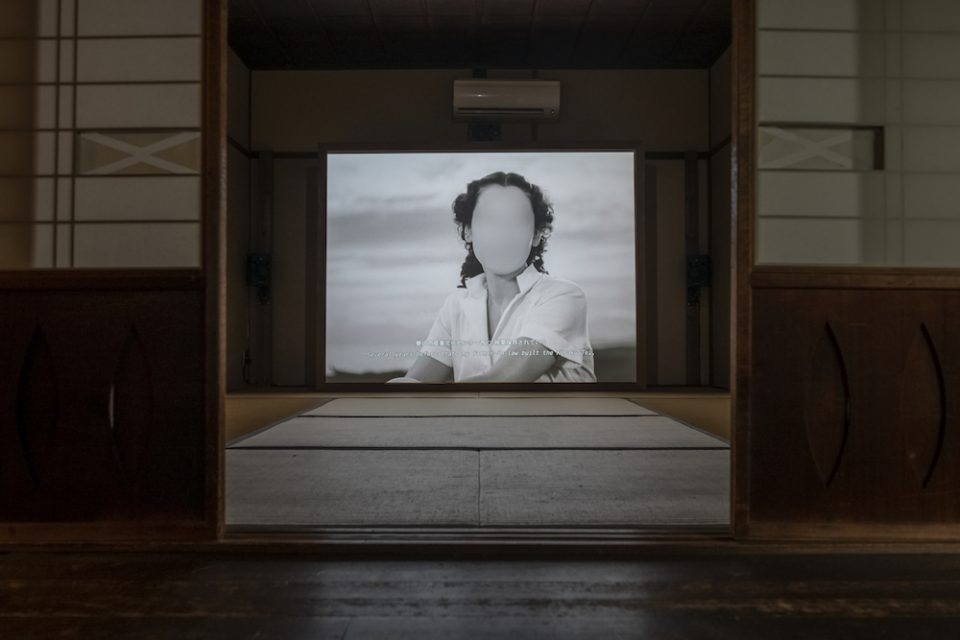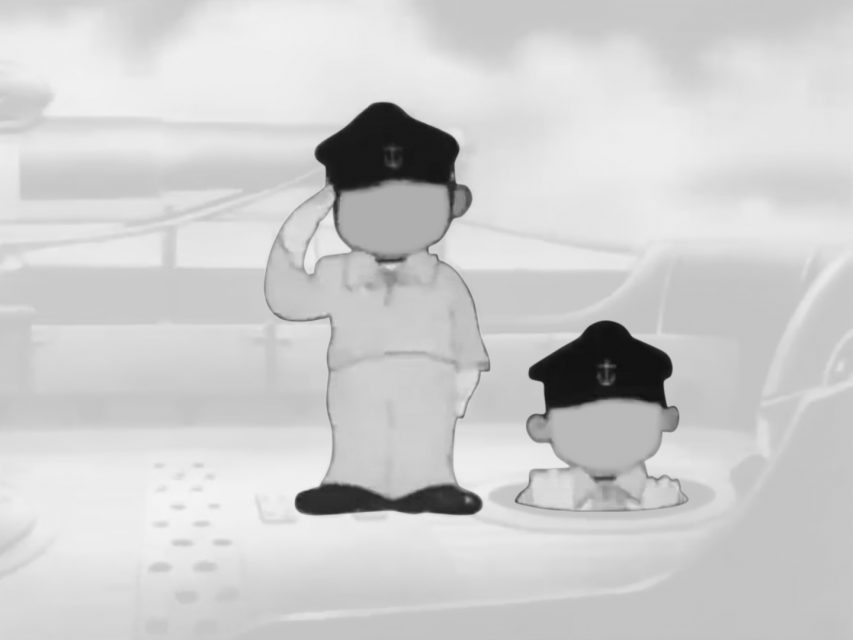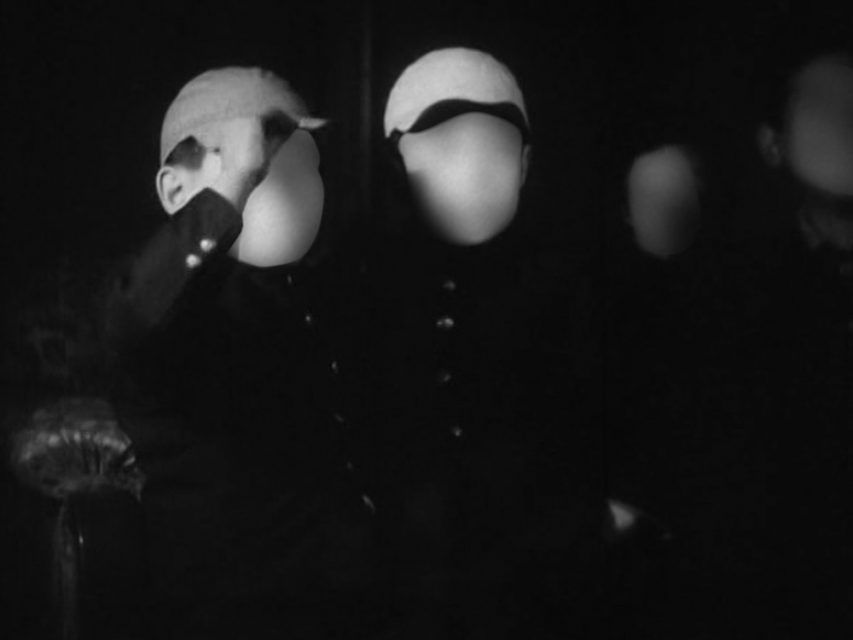LEAP BEYOND VOID
By Andrew Maerkle
 Hotel Aporia (2019), site-specific installation at Kirakutei, Toyota, 6-channel video projection, 24-channel sound, automated fan, lights, transducers and show control system, installation view. Photo Hiroshi Tanigawa. All images: Unless otherwise noted, courtesy Ho Tzu Nyen.
Hotel Aporia (2019), site-specific installation at Kirakutei, Toyota, 6-channel video projection, 24-channel sound, automated fan, lights, transducers and show control system, installation view. Photo Hiroshi Tanigawa. All images: Unless otherwise noted, courtesy Ho Tzu Nyen.
Born in Singapore in 1976, Ho Tzu Nyen brings a distinctive combination of philosophical inquiry, wry humor, and dark sensibility to his video, film, multimedia, and curatorial projects. The breadth of his activities is in part driven by his overarching investigation into the intersections of history, myth, and politics as they play out in postcolonial Southeast Asia. In one of his earliest works, Utama—Every Name in History is I (2003), which comprises a video and 20 history painting–style portraits, Ho revisits the origin story of Singapore’s discovery and naming in 1299 by the Srivijayan prince Sang Nila Utama. Using the same actor to represent Utama and explorers from across different eras including Zheng He, Christopher Columbus, and Stamford Raffles, Ho highlights the fictive elements of the origin story while simultaneously relativizing the modern narrative of colonial Singapore’s founding in 1819 by the British Raffles. The work suggests that institutional history is as much a process of overwriting the past as it is one of constructing knowledge for the future—and therefore is always already inscribed with its own archaeology. In other cases Ho draws on tropes from horror cinema and the uncanny valley effect of realistic digital animation to unpack the residual traumas of the colonizer–colonized encounter, as in the video installations 2 or 3 Tigers (2015) and One or Several Tigers (2017), which center on the shapeshifting weretiger of Malayan legend. Since 2012 Ho has organized much of his work under the rubric of the Critical Dictionary of Southeast Asia (CDOSEA), a research project into the question What constitutes the unity of Southeast Asia? Structured around alphabetically organized keywords, ranging from “a for altitude, anarchism” to “z for zone, zoomorphism,” CDOSEA is both an archive of audiovisual representations of Southeast Asia and an engine for producing new works, including algorithmically edited montages of the source material.
While Ho’s work for Aichi Triennale 2019 is not stictly part of the CDOSEA, it builds on a similar methodology. A site-specific commission for a former ryokan in Toyota, Hotel Aporia delves into the history of the site and its latent connections to the Kyoto School of philosophy, political intrigues in the Japanese military during World War II, a unit of “kamikaze” special attack pilots and cultural workers such as the filmmaker Yasujiro Ozu and the animator Ryuichi Yokoyama. Integrating his video installations into the architecture of the building, Ho evokes the spectral presence haunting this history with the use of low-frequency sound effects and an industrial fan to animate the building itself.
ART iT met with Ho Tzu Nyen in Singapore in November 2019, following the conclusion of the Aichi Triennale, to ask his reflections on the controversy over freedom of expression at the Triennale and learn about how his work relates to it.
I.
 Still from Hotel Aporia (2019).
Still from Hotel Aporia (2019).
ART iT: Aichi Triennale 2019 was the biggest art event in Japan in recent history, and your work was considered one of the most successful on view. Much of the discussion about the closure of displays in the exhibition centered on free speech and censorship, but one of the issues underlying the controversy is historical consciousness, and how we relate to history, memory, and narrative. This has been a core theme of your practice going back to early works such as Utama: Every Name in History Is I (2003). With that in mind, what is your view on what happened at Aichi?
HTZ: My experience with what happened at Aichi is skewed, first because I am an outsider, and second because my understanding of what was unfolding at Aichi was filtered by the experience of making my own work for the exhibition, which looks at Japanese history during World War II through the biographical trajectories of several historical personages, including Yasujiro Ozu, the Kusanagi unit of kamikaze pilots and the philosophers of the Kyoto School. Inevitably, my first reaction was that, at a deep cultural level, certain tendencies from the Japan of the late 1930s and early 1940s seem to persist in the present.
When I first proposed my project for Aichi, I was questioned about why I wanted to deal with the Kyoto School. I suppose that many people in the arts that I engaged with in Japan have left-leaning tendencies, and I had the sense that they were dismissive of the Kyoto School—even if no one really knew exactly what the various members of the school did, said or wrote.
But that only made me more interested in doing the research. I had the impression—all the more intensified in the post-Aichi context—that the classifications of left and right are somewhat rigid in Japan. It’s like whenever you speak to anyone about another person, they will immediately tell you where they think that person is on the political spectrum: Oh, he’s to the center. He’s center-left. He’s extreme left. Everyone is slotted in a position on the spectrum. This made me think about what Keiji Nishitani once said—that during the war the members of the Kyoto School were slapped on the cheek by the right, and after the war they were slapped on the other cheek by the left. That comment was another thing that got me interested in the Kyoto School, and the idea of how we can rethink politics in Asia.
ART iT: Of course the Greater East Asia Co-Prosperity Sphere concept itself borrowed from left-wing rhetoric, only to end up getting co-opted along with Pan-Asianism as a militarist discursive tool. This also has parallels with National Socialism in Germany and Fascism in Italy. We often find the left and right entangled in each other.
HTZ: Yes, one of the key architects of the Greater East Asia Co-Prosperity Sphere was Kiyoshi Miki, who is sometimes regarded as the left wing of the Kyoto School. Due to his involvement with the Showa Research Association, his idea of the East Asian Cooperative Community most certainly got absorbed into the imperialist discourse of the time. But Miki is a great example of the confusion of the left and the right in Japan then.
I believe he published texts that he might not necessarily have fully believed in in order to survive and to make a living. But he also had personal connections to communists, which led to his arrest and eventual demise. He struck me as someone who was curious, open to ideas, and inconsistent. In 1942 he was sent to the Philippines as part of an imperial army propaganda unit, where he was said to be involved in drafting military administration policies. These situations create strange positions that we cannot readily identify as being either on the left or on the right.
In hindsight, I believe that one of the main things that drew me to the Japanese history of this period is the coexistence of this inconsistency with a broader tendency for rigid classification. For example, I’ve always been fascinated by how the discourse of Pan-Asianism was associated with what we might identify as right-wing, ultranationalist associations and groups. Yet the concept of Pan-Asianism surely entailed the dissolution of national borders. I’ve always found it interesting that so many nationalists and anticolonialists from all across Asia sought refuge in Japan in the early 20th century with the support and funding of right-wing associations—Sun Yat-sen being a prime example.
This inconsistency or contradiction can also be found in another figure related to the Kyoto School—Daisetsu Suzuki, or D.T. Suzuki, as he is known in the West. After the war Suzuki was crucial in repairing the image of Japan in the US through his teachings on Zen and his influence on artists such as John Cage. Suzuki is known as a pacifist, but he has texts from the 1890s in which he describes war against China as a religious act. So he was pacifist only in regard to the US, but not Asia. Instead, he cast the colonization of Japan’s neighbors as a moral act. What were Zen scholars doing promoting war? He was not the only one. And I also started thinking about how Chan Buddhism became intertwined with samurai culture when it got to Japan from China.
ART iT: Right. The tea ceremony was closely associated with both Zen and samurai culture.
HTZ: And the art of archery, too. You can see how it all fits with the samurai aesthetic and vision of life. How does Buddhism get wrapped up in the techniques of violence and killing of samurai culture, which in many ways culminated in kamikaze culture? This led me to a kind of inconsistency at the root of Kyoto School philosophy. For example, Kitaro Nishida’s foundational concept of zettai mu, or “absolute nothingness”: It is absolute but nothing at the same time. It is intuited through Zen discipline, yet at the same time it also became the foundation of a philosophical system based on rational thought and argument. In hindsight, the feeling of this inconsistency began proliferating through all the things I was researching, and that in turn informed my understanding of the censorship controversy at Aichi. Japan’s constitution guarantees freedom of expression, but you also have politicians, such as Nagoya mayor Takashi Kawamura, who use the mass media and social media to subvert the constitution.
I am a great admirer of many aspects of Japanese traditional and contemporary culture, but there are also definitely parts that disturb me. Perhaps the beauty and the terror are inextricably entwined together. So that’s where I am a few months after Aichi. I am still working out for myself what this means or where we can go from here.

Still from Hotel Aporia (2019).
ART iT: Then in a sense your Aichi work is only a provisional thesis?
HTN: You can say that the work exists because I could not figure things out. Since I started consciously researching this subject only two years ago, I had no illusions that I would arrive at any answers that might be useful for anyone else within that time. But while I am committed to getting answers on a personal level, I am interested in questions that have no easy answers in my works. One of the starting points for this work was the Kyoto School. But I began thinking about the former ryokan that the curator Yoko Nose wanted me to work in, Kirakutei, as a literal hotel. A hotel to be populated by not only the second generation thinkers of the Kyoto School, but also their contemporaries: the animator Ryuichi Yokoyama, the film director Yasujiro Ozu, the Kusanagi unit of kamikaze pilots and the landlady of the Kirakutei.
ART iT: If you started your research before you were approached by Aichi, what got you into it in the first place?
HTN: The blame falls squarely on Park Chan-Kyong. We were in an exhibition together at the Haus der Kulturen der Welt in Berlin, “2 or 3 Tigers.” Chan-Kyong did a work on the Kyoto School that included a book on three roundtables that were held in 1941–42 on the standpoint of world history and Japan and later published in the magazine Chuo Koron. Many people are aware of the “Overcoming Modernity” symposium of 1942, but this book featured a smaller gathering of only four Kyoto School thinkers. I was intrigued to learn about it, and I had the chance to have some conversations with Chan-Kyong about it.
A fascinating thing about the book is that the translator, David Williams, wrote commentaries on the three roundtables that were almost as long as the translations themselves. He claims that the only way one could understand his translations is through context, which is why he had to write so much. Williams identifies himself as a revisionist philosopher and historian, and has a highly rhetorical way of writing and trying to reconfigure our understanding of Japan during the war years. Despite being suspicious of many of the arguments he was making, I was simultaneously drawn into what he was doing. For him, our understanding of Japan in the 1940s is produced by what he calls a post-Holocaust liberal framework, which he was trying to challenge. Interestingly, he identifies himself as being on the left, but I am not quite sure when I read him. I guess the aporetic was already there in my first encounter with the Kyoto School.
Ho Tzu Nyen: Leap beyond Void
